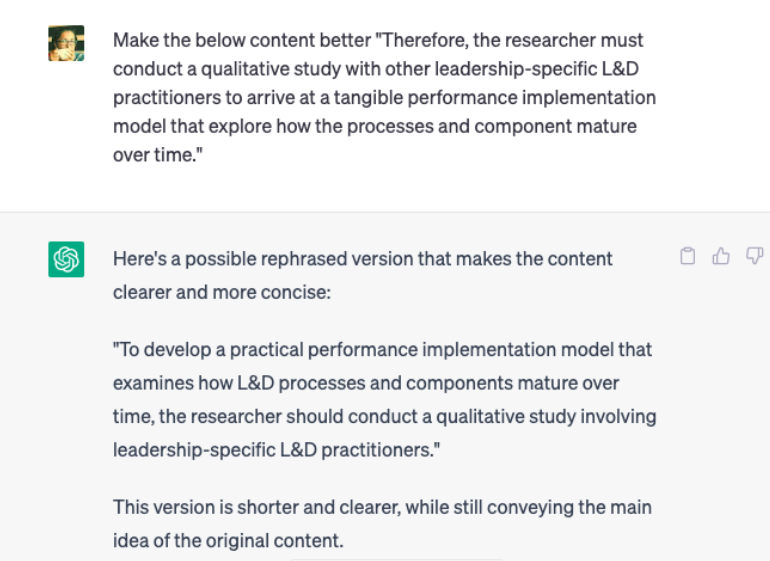How ChatGPT can help create better e-learning content
ChatGPT is a valuable tool in supporting e-learning authors—especially in the context of Employee-generated Learning. Here’s how it can help you create better learning content, faster.

There’s no denying the impact that AI and, more specifically, ChatGPT have across industries. AI databases are filled with content that is scraped from the web. And now, with ChatGPT, it’s easier than ever to access this content. It processes and analyzes the data for you, and presents only the most relevant information.
But for us L&D professionals, there are a few questions that come up:
- How will AI technology impact learning content creation?
- Is it good enough to replace people when designing and creating learning content?
- And, can it replace instructional designers altogether?
The answer is no. At least, not yet.
What it can do is support authors in creating better content faster.
With its current capabilities and intelligence, AI is a valuable tool in supporting authors to create better content faster. It’s even more valuable in the context of Employee-generated Learning, which is content created by employees and SMEs outside of the L&D space. Because for some, employee-generated content raises quality concerns. The authors generally have no prior experience in content creation. And this is precisely where AI comes into play.
By leveraging the vast amount of knowledge available through AI, employees can create more effective and engaging learning resources for their peers. (Although it’s still up to the SMEs to provide relevance and context.)
How AI can help create better learning content
AI technology can speed up the learning content creation process in several ways:
1. Improving quality of content from a language perspective
SMEs have vast knowledge and expertise to share, but they may or may not be able to convey these clearly and effectively. After all, they’re experts in their fields but not in teaching or storytelling. ChatGPT can significantly help authors improve a piece of content.
2. Helping overcome writer’s block
A common fear among authors when sharing knowledge is their bias toward the content creation process. Getting started can be difficult, and there may be significant resistance on their part. ChatGPT can act as an assistant, offering gentle nudges and guidance to help SMEs share their expertise. Here are a couple of ways:
- When an SME is stuck on a topic, ChatGPT can generate a number of prompts to spark some imagination and get the writing process going.
- If an author creates content that is difficult to understand, the AI tool can generate an outline that helps to structure their ideas. Or, it can restructure the piece in a more coherent way.
- AI can provide new ideas and perspectives to help writers think of different ways to write. For example, it can offer suggestions for repurposing their content into multiple styles.
3. Repurposing content
ChatGPT is trained to generate content in various writing styles, such as formal, informal, technical, academic, persuasive, and descriptive styles. This means that you can easily input an academic article and ask it to generate a short video script based on it. Or you can input a technical whitepaper and ask for a summary in simple terms. So, in addition to providing grammar checks, ChatGPT can also help SMEs save time by adapting their content to multiple purposes.
4. Translating content
ChatGPT can be used to translate text. Although the translation may not be as accurate as that of a professional translator, it can still provide a head start in this direction. This speeds up processes and reduces the capacity required for translators. Instead of working from scratch, they can provide slight corrections or localization edits on the AI-generated translation.
Limitations of ChatGPT
While ChatGPT is excellent at scraping the web, improving language or changing formats, it cannot generate the technical knowledge itself. It’s only as smart as the generic content it finds on the web. Therefore, SMEs must still review AI-generated content for faulty information or unclear reasoning. It’s also a good idea to enrich this content with personal examples and expertise.
See the example below, where ChatGPT improved the content’s language but failed to include the necessary contextual details to provide a complete picture.

For ChatGPT, “make the content better” only involves fixing the sentences. In other words, paraphrasing. In comparison, an SME would improve the content by adding context, providing explanations, including examples, and more.
Context and relevance are crucial to transforming a text into learning content that employees can use to solve work-related challenges. This is the key difference between content written by ChatGPT as opposed to an SME. We’ll dive further into these differences in another blog soon.
Ultimately, AI does what it’s asked to do—not more, not less. At least, not yet. SMEs have the knowledge to add a contextual layer which they draw from their experiences, thus making the content much more relevant to the reader.
So while we’re aware of the important place ChatGPT has carved itself in the content world, it’s only a loyal AI assistant to people and not a substitution.
























